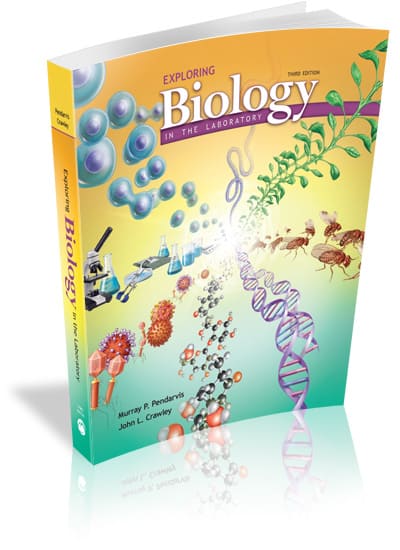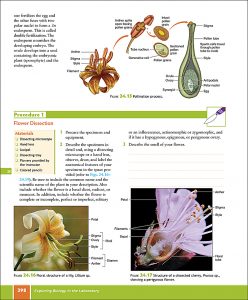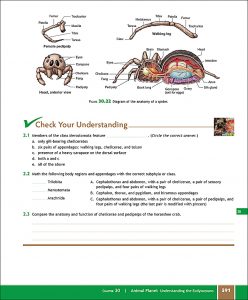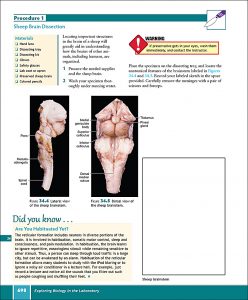Chapter 1: The Starting Point: Understanding the Scientific Method
Objectives & Intro Material
Exercise 1.1: Practicing the Scientific Method with Termites
Exercise 1.2: Applying the Scientific Method with Goldfish
Exercise 1.3: Reinforcing Scientific Skills with Gummy Bears
Chapter 2: For Good Measure: Understanding Scientific Notation and the Metric System
Objectives & Intro Material
Exercise 2.1: Using Scientific Notation
Exercise 2.2: Learning the Metric System and Conversions
Exercise 2.3: Measuring Length, Mass, Volume, and Temperature
Chapter 3: The Invisible World: Understanding Microscopy
Chapter 3 Objectives & Intro Material
Exercise 3.1: Learning about Microscopy
Exercise 3.2: Developing the Skills of Microscopy
Exercise 3.3: Preparing Slides
Exercise 3.4: Using the Stereomicroscope (Dissecting Microscope)
Chapter 4: Back to Basics: Understanding Acids, Bases, and pH
Chapter 4 Objectives & Intro Material
Exercise 4.1: Measuring pH
Exercise 4.2: Neutralizing Acids
Chapter 5: The Composition of Living Things: Understanding Organic Molecules
Chapter 5 Objectives & Intro Material
Exercise 5.1: Testing for Carbohydrates
Exercise 5.2: Testing for Lipids
Exercise 5.3: Testing for Proteins
Exercise 5.4: Testing an Unknown
Chapter 6: The Building Blocks of Life: Understanding Cell Structure and Function
Chapter 6 Objectives & Intro Material
Exercise 6.1: Observing Prokaryotic Cells
Exercise 6.2: Observing Eukaryotic Cells
Exercise 6.3: Observing Plant Cells
Exercise 6.4: Observing Animal Cells
Chapter 7: Catalysts for Change: Understanding Enzymes
Chapter 7 Objectives & Intro Material
Exercise 7.1: Bromelain as an Enzyme
Exercise 7.2: Catalase and Reusability of Enzymes
Exercise 7.3: Application of Rennilase
Chapter 8: Just Passing Through: Understanding Diffusion and Osmosis
Chapter 8 Objectives & Intro Material
Chapter 9: From Light to Energy: Understanding Photosynthesis
Chapter 9 Objectives & Intro Material
Exercise 9.1: Leaf Structure
Exercise 9.2: Plant Pigments
Exercise 9.3: Photosynthesis in Elodea
Chapter 10: Breaking Bonds: Understanding Cellular Respiration
Chapter 10 Objectives & Intro Material
Exercise 10.1: Observing Alcoholic Fermentation
Exercise 10.2: Aerobic Respiration
Chapter 11: Out of One, Many: Understanding Cell Division
Chapter 11 Objectives & Intro Material
Exercise 11.1: The Cell Cycle
Chapter 12: That's Just the Half of It: Understanding Meiosis
Chapter 12 Objectives & Intro Material
Exercise 12.1: Meiosis in Animals
Exercise 12.2: Meiosis in Plants
Chapter 13: It's All in the Genes: Understanding Basic Mendelian Genetics
Chapter 13 Objectives & Intro Material
Exercise 13.1: Understanding Heredity
Exercise 13.2: Population Genetics
Exercise 13.3: The Corn Maize
Exercise 13.4: Fitting In
Exercise 13.5: Blood Groups
Exercise 13.6: Developing Pedigrees
Chapter 14: Unraveling the Double Helix: Understanding DNA and the Genetic Code
Chapter 14 Objectives & Intro Material
Exercise 14.1: Isolating DNA
Exercise 14.2: Solving a World War II Mystery: The Plight of the Lady Be Good
Chapter 15: Touching the Future: Understanding Biotechnology and Forensics
Chapter 15 Objectives & Intro Material
Exercise 15.1: Applications of Gel Electrophoresis
Chapter 16: Mystery of Mysteries: Understanding Evolution
Chapter 16 Objectives & Intro Material
Exercise 16.1: Adaptation Evidence
Exercise 16.2: Paleontological Evidence
Exercise 16.3: Comparative Anatomical Evidence
Exercise 16.4: Embryological Evidence
Exercise 16.5: Molecular Evidence
Chapter 17: Making Sense of Diversity: Understanding Classification
Chapter 17 Objectives & Intro Material
Exercise 17.1: Using a Dichotomous Key
Exercise 17.2: Constructing a Cladogram
Chapter 18: On the Edge of Life: Understanding Viruses
Chapter 18 Objectives & Intro Material
Exercise 18.1: Communicable Disease
Chapter 19: The Good, the Bad, and the Ugly: Understanding Bacteria
Chapter 19 Objectives & Intro Material
Exercise 19.1: Observing Bacteria
Exercise 19.2: Gram Stain
Exercise 19.3: Finding Bacteria
Exercise 19.4: Using Antibiotics
Exercise 19.5: Observing Bioluminescence
Chapter 20: This Fine Mess: Understanding the Protists
Chapter 20 Objectives & Intro Material
Exercise 20.1: Sharing van Leeuwenhoek’s Enthusiasm
Exercise 20.2: Plantlike (Photosynthetic) Protists
Exercise 20.3: Fungus-like Protists
Exercise 20.4: Animallike (Heterotrophic) Protists
Chapter 21: The Green Machine: Understanding the Nonvascular Plants
Chapter 21 Objectives & Intro Material
Exercise 21.1: Phylum Hepatophyta
Exercise 21.2: Phylum Anthocerophyta
Exercise 21.3: Phylum Bryophyta
Chapter 22: The Green Machine: Understanding the Seedless Vascular Plants
Chapter 22 Objectives & Intro Material
Exercise 22.1: Phylum Lycophyta
Exercise 22.2: Phylum Psilotophyta
Exercise 22.3: Phylum Sphenophyta
Exercise 22.4: Phylum Pterophyta
Chapter 23: The Green Machine: Understanding the Seed Plants (Gymnosperms)
Chapter 23 Objectives & Intro Material
Exercise 23.1: Phylum Cycadophyta
Exercise 23.2: Phylum Ginkgophyta
Exercise 23.3: Phylum Gnetophyta
Exercise 23.4: Phylum Coniferophyta (Pinophyta)
Chapter 24: The Green Machine: Understanding the Seed Plants (Angiosperms)
Chapter 24 Objectives & Intro Material
Exercise 24.1: Phylum Magnoliophyta
Chapter 25: The Green Machine: Understanding Roots, Stems, and Leaves
Chapter 25 Objectives & Intro Material
Exercise 25.1: Plant Histology
Chapter 26: There's a Fungus among Us: Understanding Fungi
Chapter 26 Objectives & Intro Material
Exercise 26.1: Phylum Chytridiomycota
Exercise 26.2: Phylum Zygomycota
Exercise 26.3: Phylum Glomeromycota
Exercise 26.4: Phylum Ascomycota
Exercise 26.5: Phylum Basidiomycota
Chapter 27: From the Skin In: Understanding Basic Animal Tissues
Chapter 27 Objectives & Intro Material
Exercise 27.1: Epithelial Tissue
Exercise 27.2: Connective Tissue
Exercise 27.3: Muscular Tissue
Exercise 27.4: Nervous Tissue
Chapter 28: Animal Planet: Understanding Creatures from the Sea
Chapter 28 Objectives & Intro Material
Exercise 28.1: Phylum Porifera
Exercise 28.2: Phylum Cnidaria
Exercise 28.3: Phylum Ctenophora
Chapter 29: Animal Planet: Understanding the Lophotrochozoans
Chapter 29 Objectives & Intro Material
Exercise 29.1: Phylum Platyhelminthes
Exercise 29.2: Phylum Rotifera
Exercise 29.3: Phylum Mollusca
Exercise 29.4: Phylum Annelida
Chapter 30: Animal Planet: Understanding the Ecdysozoans
Chapter 30 Objectives & Intro Material
A Closer Look: Other Ecdysozoans
Exercise 30.1: Phylum Nematoda
Exercise 30.2: Phylum Arthropoda, Subphylum Chelicerata
A Closer Look: Other Arachnids
Exercise 30.3: Phylum Arthropoda, Subphylum Myriapoda
Exercise 30.4: Phylum Arthropoda, Subphylum Crustacea
Exercise 30.5: Phylum Arthropoda, Subphylum Hexapoda
Chapter 31: Animal Planet: Understanding the Deuterostomes
Chapter 31 Objectives & Intro Material
Exercise 31.1: Phylum Echinodermata
Exercise 31.2: Phylum Hemichordata and the Invertebrates of Phylum Chordata
Exercise 31.3: Phylum Chordata, Subphylum Vertebrata (Craniata)
Chapter 32: The Cutting Edge: Understanding Vertebrate Dissections
Chapter 32 Objectives & Intro Material
Exercise 32.1: Dissection of Common Chordates
Chapter 33: Homo sapiens: Understanding the Structure of the Human Body
Chapter 33 Objectives & Intro Material
Exercise 33.1: Integumentary System
Exercise 33.2: Skeletal System
Exercise 33.3: Articulations
Exercise 33.4: Muscular System
Chapter 34: Homo sapiens: Understanding the Nervous System and Special Senses
Chapter 34 Objectives & Intro Material
Exercise 34.1: Regions of the Human Brain
Exercise 34.2: Special Senses of Smell and Taste
Exercise 34.3: Special Senses of Hearing and Equilibrium
Exercise 34.4: Special Sense of Vision
Exercise 34.5: Anatomy of the Eye
Exercise 34.6: Sense of Touch
Chapter 35: Homo sapiens: Understanding the Cardiovascular and Respiratory Systems
Chapter 35 Objectives & Intro Material
Exercise 35.1: Cardiovascular System
Exercise 35.2: Cardiovascular System in Action
Exercise 35.3: Respiratory System
Chapter 36: Homo sapiens: Understanding Other Systems of the Body
Chapter 36 Objectives & Intro Material
Exercise 36.1: Endocrine System
Exercise 36.2: Digestive System
Exercise 36.3: Urinary System
Exercise 36.4: Reproductive Systems
Chapter 37: A Womb with a View: Understanding Embryology
Chapter 37 Objectives & Intro Material
Exercise 37.1: Observing Embryological Development
Exercise 37.2: Observing Viable Chicken Eggs
Chapter 38: Acting It Out: Understanding Animal Behavior
Chapter 38 Objectives & Intro Material
Exercise 38.1: The Ethogram
Exercise 38.4: Agonistic Behavior
Chapter 39: But One Earth: Understanding Basic Ecology
Chapter 39 Objectives & Intro Material
Exercise 39.1: Investigating Local Ecosystems
Exercise 39.2: Observing Ecological Succession
Exercise 39.3: Species Decline
Exercise 39.4: Effects of Oil as a Pollutant
Appendix A: Digital Field Trips




